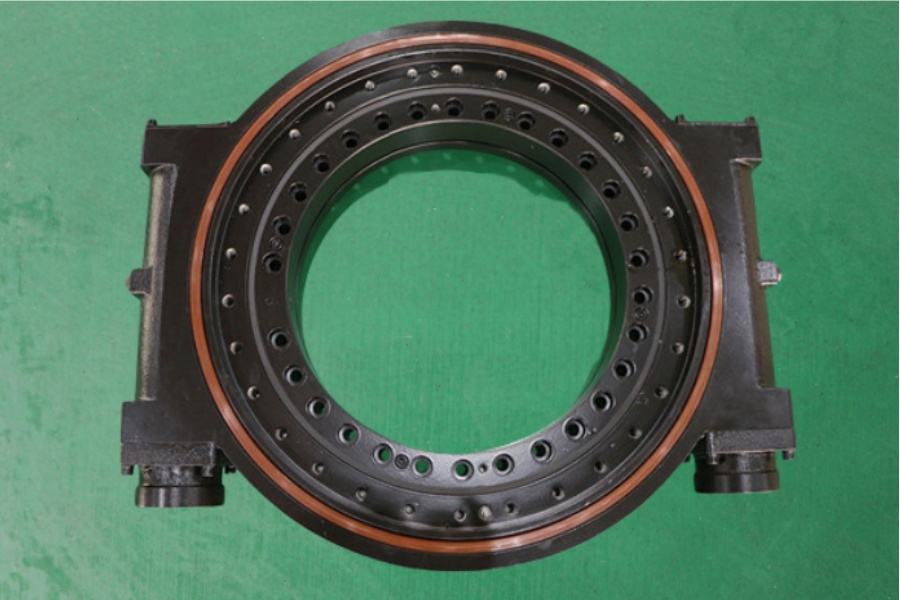Slewing bearings play a significant role in the industrial field. They enable the flexible rotation of equipment components, withstand axial and radial loads as well as overturning moments, enhance stability and work efficiency, and are applied to various types of machinery.
What is slew drive?
Slew drive is a kind of slewing drive device, which has the characteristics of high load capacity, high precision, compact design, good sealing performance, high integration degree, convenient installation and maintenance, large transmission ratio, and high safety. It can play an important role in a variety of different industrial fields and equipment, achieving precise rotary motion and reliable load support.
Electric Motors and Generators
Application: Bearings are used in electric motors and generators to support the rotor, reduce friction, and ensure smooth rotation.
Types: Deep groove ball bearings, cylindrical roller bearings, angular contact ball bearings, etc.
Features: High speed, low noise, long service life.
Pumps and Compressors
Application: Bearings are used to support the rotating components of pumps and compressors, and they bear radial and axial loads.
Types: Deep groove ball bearings, tapered roller bearings, thrust ball bearings, etc.
Features: High temperature resistance, corrosion resistance, high load capacity.
Fans and Blowers
Application: Bearings are used to support the fan shaft, ensuring smooth rotation and efficient operation.
Types: Deep groove ball bearings, self-aligning ball bearings, cylindrical roller bearings, etc.
Features: Low friction, low noise, long service life.
Machine Tools and Machining Centers
Application: Bearings are used to support spindles, lead screws, and guide rails, ensuring high-precision machining.
Types: Angular contact ball bearings, cylindrical roller bearings, thrust ball bearings, etc.
Features: High precision, high rigidity, high speed.
Conveyors and Belt Systems
Application: Bearings are used to support the rollers and drive shafts of conveyors, ensuring smooth operation.
Types: Deep groove ball bearings, self-aligning ball bearings, tapered roller bearings, etc.
Features: High load capacity, impact resistance, long service life.
Heavy Machinery
Application: Bearings are used to support rotating components in heavy machinery such as excavators, cranes, and bulldozers.
Types: Tapered roller bearings, spherical roller bearings, cylindrical roller bearings, etc.
Features: High load capacity, impact resistance, wear resistance.
Mining Machinery
Application: Bearings are used to support rotating components in mining machinery such as crushers, ball mills, and screening machines.
Types: Spherical roller bearings, cylindrical roller bearings, tapered roller bearings, etc.
Features: High load capacity, impact resistance, wear resistance.
Paper Machinery
Application: Bearings are used to support rotating components in paper machinery such as rollers, calenders, and winders.
Types: Cylindrical roller bearings, spherical roller bearings, angular contact ball bearings, etc.
Features: High temperature resistance, corrosion resistance, high precision.
Food and Beverage Machinery
Application: Bearings are used to support rotating components in food and beverage machinery such as mixers, fillers, and packaging machines.
Types: Stainless steel bearings, food-grade grease bearings, etc.
Features: Corrosion resistance, compliance with food safety standards.
Textile Machinery
Application: Bearings are used to support rotating components in textile machinery such as spinning machines, weaving machines, and winding machines.
Types: Deep groove ball bearings, cylindrical roller bearings, angular contact ball bearings, etc.
Features: High speed, low noise, long service life.
Steel and Metallurgical Equipment
Application: Bearings are used to support rotating components in steel and metallurgical equipment such as rolling mills, continuous casters, and blast furnaces.
Types: Tapered roller bearings, spherical roller bearings, cylindrical roller bearings, etc.
Features: High temperature resistance, high load capacity, wear resistance.
Chemical Equipment
Application: Bearings are used to support rotating components in chemical equipment such as agitators, centrifuges, and pumps.
Types: Stainless steel bearings, corrosion-resistant bearings, etc.
Features: Corrosion resistance, high temperature resistance, long service life.
Energy Equipment
Application: Bearings are used to support rotating components in energy equipment such as wind turbines, hydro turbines, and gas turbines.
Types: Tapered roller bearings, spherical roller bearings, cylindrical roller bearings, etc.
Features: High load capacity, high temperature resistance, long service life.
Automation Equipment
Application: Bearings are used to support rotating components in automation equipment such as robots, conveyors, and assembly lines.
Types: Deep groove ball bearings, angular contact ball bearings, linear bearings, etc.
Features: High precision, low noise, long service life.
Bearings have a wide range of applications in the industrial field, covering almost all mechanical equipment that requires rotational or linear motion. Different types of bearings have different characteristics and are suitable for various working conditions and application scenarios. Proper selection and use of bearings can significantly improve equipment efficiency, extend service life, and reduce maintenance costs.
Supplier of slewing Bearing
Slew drive of LDB Bearing have an extremely high load capacity and can easily handle all kinds of heavy-duty operations. Even in harsh working conditions, it is no problem at all. Thanks to its compact design, you don’t have to worry about limited space during installation and can flexibly arrange it in narrow areas. Moreover, it has extremely high precision, ensuring stable operation of the equipment and accurate positioning, which greatly improves the quality of the work. With a high degree of integration, its installation and maintenance are simple and convenient, saving you a lot of time and cost. Its advantage of a large transmission ratio enables efficient power transmission, helping you easily achieve the desired rotational speed. Additionally, it has excellent sealing performance and safety features, allowing you to be fearless in harsh environments and ensuring worry-free and safe operation.

